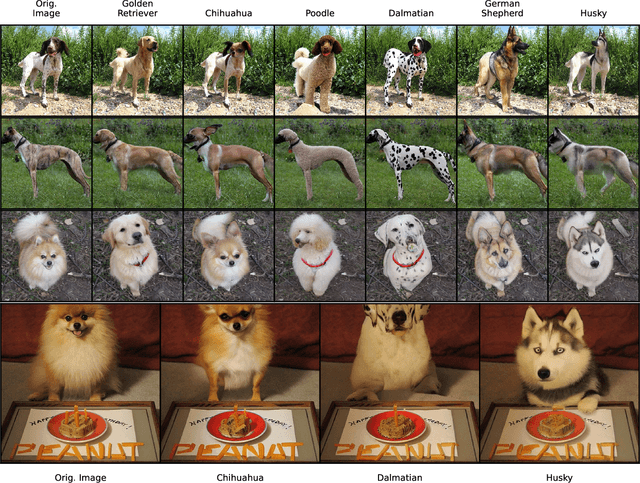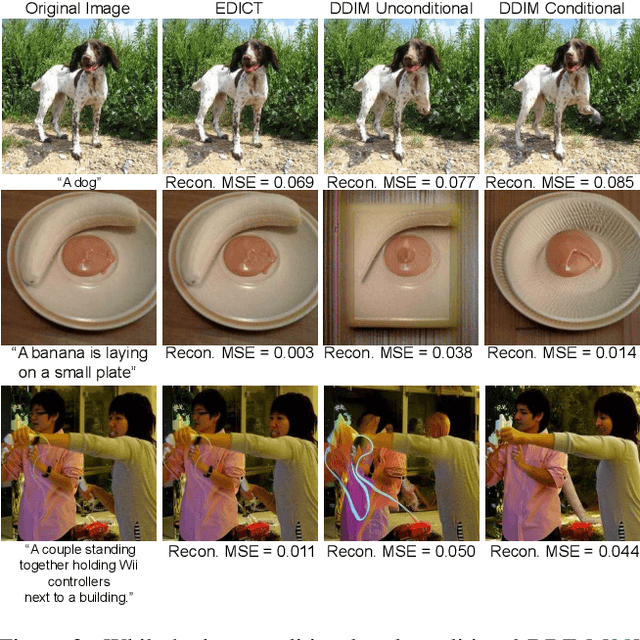Akash Gokul
LaViDa: A Large Diffusion Language Model for Multimodal Understanding
May 22, 2025Abstract:Modern Vision-Language Models (VLMs) can solve a wide range of tasks requiring visual reasoning. In real-world scenarios, desirable properties for VLMs include fast inference and controllable generation (e.g., constraining outputs to adhere to a desired format). However, existing autoregressive (AR) VLMs like LLaVA struggle in these aspects. Discrete diffusion models (DMs) offer a promising alternative, enabling parallel decoding for faster inference and bidirectional context for controllable generation through text-infilling. While effective in language-only settings, DMs' potential for multimodal tasks is underexplored. We introduce LaViDa, a family of VLMs built on DMs. We build LaViDa by equipping DMs with a vision encoder and jointly fine-tune the combined parts for multimodal instruction following. To address challenges encountered, LaViDa incorporates novel techniques such as complementary masking for effective training, prefix KV cache for efficient inference, and timestep shifting for high-quality sampling. Experiments show that LaViDa achieves competitive or superior performance to AR VLMs on multi-modal benchmarks such as MMMU, while offering unique advantages of DMs, including flexible speed-quality tradeoff, controllability, and bidirectional reasoning. On COCO captioning, LaViDa surpasses Open-LLaVa-Next-8B by +4.1 CIDEr with 1.92x speedup. On bidirectional tasks, it achieves +59% improvement on Constrained Poem Completion. These results demonstrate LaViDa as a strong alternative to AR VLMs. Code and models will be released in the camera-ready version.
xGen-small Technical Report
May 10, 2025Abstract:We introduce xGen-small, a family of 4B and 9B Transformer decoder models optimized for long-context applications. Our vertically integrated pipeline unites domain-balanced, frequency-aware data curation; multi-stage pre-training with quality annealing and length extension to 128k tokens; and targeted post-training via supervised fine-tuning, preference learning, and online reinforcement learning. xGen-small delivers strong performance across various tasks, especially in math and coding domains, while excelling at long context benchmarks.
Reflect-DiT: Inference-Time Scaling for Text-to-Image Diffusion Transformers via In-Context Reflection
Mar 15, 2025Abstract:The predominant approach to advancing text-to-image generation has been training-time scaling, where larger models are trained on more data using greater computational resources. While effective, this approach is computationally expensive, leading to growing interest in inference-time scaling to improve performance. Currently, inference-time scaling for text-to-image diffusion models is largely limited to best-of-N sampling, where multiple images are generated per prompt and a selection model chooses the best output. Inspired by the recent success of reasoning models like DeepSeek-R1 in the language domain, we introduce an alternative to naive best-of-N sampling by equipping text-to-image Diffusion Transformers with in-context reflection capabilities. We propose Reflect-DiT, a method that enables Diffusion Transformers to refine their generations using in-context examples of previously generated images alongside textual feedback describing necessary improvements. Instead of passively relying on random sampling and hoping for a better result in a future generation, Reflect-DiT explicitly tailors its generations to address specific aspects requiring enhancement. Experimental results demonstrate that Reflect-DiT improves performance on the GenEval benchmark (+0.19) using SANA-1.0-1.6B as a base model. Additionally, it achieves a new state-of-the-art score of 0.81 on GenEval while generating only 20 samples per prompt, surpassing the previous best score of 0.80, which was obtained using a significantly larger model (SANA-1.5-4.8B) with 2048 samples under the best-of-N approach.
OmniFlow: Any-to-Any Generation with Multi-Modal Rectified Flows
Dec 02, 2024



Abstract:We introduce OmniFlow, a novel generative model designed for any-to-any generation tasks such as text-to-image, text-to-audio, and audio-to-image synthesis. OmniFlow advances the rectified flow (RF) framework used in text-to-image models to handle the joint distribution of multiple modalities. It outperforms previous any-to-any models on a wide range of tasks, such as text-to-image and text-to-audio synthesis. Our work offers three key contributions: First, we extend RF to a multi-modal setting and introduce a novel guidance mechanism, enabling users to flexibly control the alignment between different modalities in the generated outputs. Second, we propose a novel architecture that extends the text-to-image MMDiT architecture of Stable Diffusion 3 and enables audio and text generation. The extended modules can be efficiently pretrained individually and merged with the vanilla text-to-image MMDiT for fine-tuning. Lastly, we conduct a comprehensive study on the design choices of rectified flow transformers for large-scale audio and text generation, providing valuable insights into optimizing performance across diverse modalities. The Code will be available at https://github.com/jacklishufan/OmniFlows.
Aligning Diffusion Models by Optimizing Human Utility
Apr 06, 2024



Abstract:We present Diffusion-KTO, a novel approach for aligning text-to-image diffusion models by formulating the alignment objective as the maximization of expected human utility. Since this objective applies to each generation independently, Diffusion-KTO does not require collecting costly pairwise preference data nor training a complex reward model. Instead, our objective requires simple per-image binary feedback signals, e.g. likes or dislikes, which are abundantly available. After fine-tuning using Diffusion-KTO, text-to-image diffusion models exhibit superior performance compared to existing techniques, including supervised fine-tuning and Diffusion-DPO, both in terms of human judgment and automatic evaluation metrics such as PickScore and ImageReward. Overall, Diffusion-KTO unlocks the potential of leveraging readily available per-image binary signals and broadens the applicability of aligning text-to-image diffusion models with human preferences.
BootPIG: Bootstrapping Zero-shot Personalized Image Generation Capabilities in Pretrained Diffusion Models
Jan 25, 2024



Abstract:Recent text-to-image generation models have demonstrated incredible success in generating images that faithfully follow input prompts. However, the requirement of using words to describe a desired concept provides limited control over the appearance of the generated concepts. In this work, we address this shortcoming by proposing an approach to enable personalization capabilities in existing text-to-image diffusion models. We propose a novel architecture (BootPIG) that allows a user to provide reference images of an object in order to guide the appearance of a concept in the generated images. The proposed BootPIG architecture makes minimal modifications to a pretrained text-to-image diffusion model and utilizes a separate UNet model to steer the generations toward the desired appearance. We introduce a training procedure that allows us to bootstrap personalization capabilities in the BootPIG architecture using data generated from pretrained text-to-image models, LLM chat agents, and image segmentation models. In contrast to existing methods that require several days of pretraining, the BootPIG architecture can be trained in approximately 1 hour. Experiments on the DreamBooth dataset demonstrate that BootPIG outperforms existing zero-shot methods while being comparable with test-time finetuning approaches. Through a user study, we validate the preference for BootPIG generations over existing methods both in maintaining fidelity to the reference object's appearance and aligning with textual prompts.
CodeChain: Towards Modular Code Generation Through Chain of Self-revisions with Representative Sub-modules
Oct 13, 2023Abstract:Large Language Models (LLMs) have already become quite proficient at solving simpler programming tasks like those in HumanEval or MBPP benchmarks. However, solving more complex and competitive programming tasks is still quite challenging for these models - possibly due to their tendency to generate solutions as monolithic code blocks instead of decomposing them into logical sub-tasks and sub-modules. On the other hand, experienced programmers instinctively write modularized code with abstraction for solving complex tasks, often reusing previously developed modules. To address this gap, we propose CodeChain, a novel framework for inference that elicits modularized code generation through a chain of self-revisions, each being guided by some representative sub-modules generated in previous iterations. Concretely, CodeChain first instructs the LLM to generate modularized codes through chain-of-thought prompting. Then it applies a chain of self-revisions by iterating the two steps: 1) extracting and clustering the generated sub-modules and selecting the cluster representatives as the more generic and re-usable implementations, and 2) augmenting the original chain-of-thought prompt with these selected module-implementations and instructing the LLM to re-generate new modularized solutions. We find that by naturally encouraging the LLM to reuse the previously developed and verified sub-modules, CodeChain can significantly boost both modularity as well as correctness of the generated solutions, achieving relative pass@1 improvements of 35% on APPS and 76% on CodeContests. It is shown to be effective on both OpenAI LLMs as well as open-sourced LLMs like WizardCoder. We also conduct comprehensive ablation studies with different methods of prompting, number of clusters, model sizes, program qualities, etc., to provide useful insights that underpin CodeChain's success.
REX: Rapid Exploration and eXploitation for AI Agents
Jul 18, 2023Abstract:In this paper, we propose an enhanced approach for Rapid Exploration and eXploitation for AI Agents called REX. Existing AutoGPT-style techniques have inherent limitations, such as a heavy reliance on precise descriptions for decision-making, and the lack of a systematic approach to leverage try-and-fail procedures akin to traditional Reinforcement Learning (RL). REX introduces an additional layer of rewards and integrates concepts similar to Upper Confidence Bound (UCB) scores, leading to more robust and efficient AI agent performance. This approach has the advantage of enabling the utilization of offline behaviors from logs and allowing seamless integration with existing foundation models while it does not require any model fine-tuning. Through comparative analysis with existing methods such as Chain-of-Thoughts(CoT) and Reasoning viA Planning(RAP), REX-based methods demonstrate comparable performance and, in certain cases, even surpass the results achieved by these existing techniques. Notably, REX-based methods exhibit remarkable reductions in execution time, enhancing their practical applicability across a diverse set of scenarios.
End-to-End Diffusion Latent Optimization Improves Classifier Guidance
Mar 23, 2023Abstract:Classifier guidance -- using the gradients of an image classifier to steer the generations of a diffusion model -- has the potential to dramatically expand the creative control over image generation and editing. However, currently classifier guidance requires either training new noise-aware models to obtain accurate gradients or using a one-step denoising approximation of the final generation, which leads to misaligned gradients and sub-optimal control. We highlight this approximation's shortcomings and propose a novel guidance method: Direct Optimization of Diffusion Latents (DOODL), which enables plug-and-play guidance by optimizing diffusion latents w.r.t. the gradients of a pre-trained classifier on the true generated pixels, using an invertible diffusion process to achieve memory-efficient backpropagation. Showcasing the potential of more precise guidance, DOODL outperforms one-step classifier guidance on computational and human evaluation metrics across different forms of guidance: using CLIP guidance to improve generations of complex prompts from DrawBench, using fine-grained visual classifiers to expand the vocabulary of Stable Diffusion, enabling image-conditioned generation with a CLIP visual encoder, and improving image aesthetics using an aesthetic scoring network.
EDICT: Exact Diffusion Inversion via Coupled Transformations
Nov 22, 2022



Abstract:Finding an initial noise vector that produces an input image when fed into the diffusion process (known as inversion) is an important problem in denoising diffusion models (DDMs), with applications for real image editing. The state-of-the-art approach for real image editing with inversion uses denoising diffusion implicit models (DDIMs) to deterministically noise the image to the intermediate state along the path that the denoising would follow given the original conditioning. However, DDIM inversion for real images is unstable as it relies on local linearization assumptions, which result in the propagation of errors, leading to incorrect image reconstruction and loss of content. To alleviate these problems, we propose Exact Diffusion Inversion via Coupled Transformations (EDICT), an inversion method that draws inspiration from affine coupling layers. EDICT enables mathematically exact inversion of real and model-generated images by maintaining two coupled noise vectors which are used to invert each other in an alternating fashion. Using Stable Diffusion, a state-of-the-art latent diffusion model, we demonstrate that EDICT successfully reconstructs real images with high fidelity. On complex image datasets like MS-COCO, EDICT reconstruction significantly outperforms DDIM, improving the mean square error of reconstruction by a factor of two. Using noise vectors inverted from real images, EDICT enables a wide range of image edits--from local and global semantic edits to image stylization--while maintaining fidelity to the original image structure. EDICT requires no model training/finetuning, prompt tuning, or extra data and can be combined with any pretrained DDM. Code will be made available shortly.
 Add to Chrome
Add to Chrome Add to Firefox
Add to Firefox Add to Edge
Add to Edge